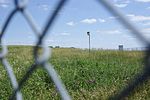The Summit (New York)
The Summit, formerly Summit Park Mall, was an enclosed shopping mall in Wheatfield, New York. Opened in 1972, the mall became largely vacant by the late 1990s. It underwent renovations in 2004 and 2005 which added new anchor stores and tenants, but after the mall's developers filed for bankruptcy protection in 2009, the complex was closed except for three anchor stores: Sears, The Bon-Ton and Save-A-Lot, with two more vacant anchors last occupied by Steve & Barry's and a Macy's closeout store. As of September 2017, Save-A-Lot has closed permanently, leaving only Sears and The Bon-Ton still open in the mall. On April 18, 2018, it was announced that The Bon-Ton would be closing in August 2018. as it is going out of business leaving Sears as the only tenant left. On May 7, 2018, Sears announced that would also be closing in August 2018. In December 2019, within Sears' old location, The Niagara International Sports & Entertainment facility opened. In 2020, a plan was proposed to revitalize the location, converting part of the mall into mixed use spaces, as well as offering lodging for visitors. Developers plan to expand the project to eventually include ice rinks, shops, and eateries.The Summit was located on Williams Road, south of US 62 (Niagara Falls Boulevard) and north of NY 265 and NY 384 (River Road).
Excerpt from the Wikipedia article The Summit (New York) (License: CC BY-SA 3.0, Authors).The Summit (New York)
Williams Road, City of Niagara Falls
Geographical coordinates (GPS) Address External links Nearby Places Show on map
Geographical coordinates (GPS)
| Latitude | Longitude |
|---|---|
| N 43.088 ° | E -78.938 ° |
Address
Williams Road 6929
14304 City of Niagara Falls
New York, United States
Open on Google Maps






